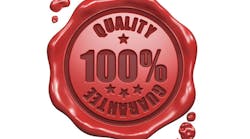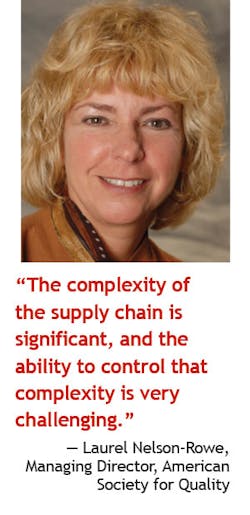Industrialist Henry Ford may have said, "Quality means doing it right when no one is looking," but the importance of quality is never so apparent as when it publicly falters.
In 2014, the automotive industry has taken center stage with respect to quality missteps. The list of auto-related recalls this year runs the gamut from airbags and axles to ignition switches and alternator problems. Food products and pharmaceutical manufacturers also have attracted their fair share of attention from government regulators.
Such incidences underline the growing challenge to quality as the world expands.
"The complexity of the supply chain is significant, and the ability to control that complexity is very challenging," says Laurel Nelson-Rowe, managing director at the Milwaukee-based American Society for Quality.
"And the criticality of quality is ever more paramount in a world where one seemingly small glitch can really be amplified" through social media channels, she adds.
November seems an appropriate time to shine a spotlight on quality. It is World Quality Month, which worldqualitymonth.org describes as a platform to recognize accomplishments in the quality field as well as the people behind those efforts and accomplishments. It also promotes the use of quality tools to reduce errors and build better products and services.
What is Quality?
Quality continues to stretch its wings, so to speak. The definition most assuredly has expanded over the years. "The meaning of quality has moved from one of compliance and control and conformance to a much broader definition," Nelson-Rowe explains.It's All About the Customer
ASQ research promotes the idea that deeper integration with the customer is a driver of improved quality. And by deeper engagement, the quality association means throughout the life cycle of the product or service.
"That means directly integrating customers into these processes to collaborate at key points where quality is critical to overall success -- not just at the point of delivery," explained ASQ in one of a series of reports related to its Global State of Quality research conducted last year.
The quality association coined the term Qustomer to describe this deeply integrated partnership.
Manufacturing companies, Nelson-Rowe says, are growing more versed in the "total customer experience." "[Quality] has evolved from a manufacturing widget product line function to more of an appreciation from the view of the customer."
She points to Apple as an example of one manufacturing company that has steeped its customers in an experience that goes beyond the physical product to the development of emotional loyalty.
"The experience Apple has given us, from the manufactured product to the packaging to the retail store to the Genius Bar, provides really interesting lessons for manufacturers generally," she says.
The continual interaction with customers also is among the factors that help distinguish companies that are very good at quality from those that are less so. "If you are proactive in your customer engagement and make them become advocates because their experience is just so good, that is a very different dynamic in the world of quality."
It's Not Just Tools, It's Culture
Quality is about tools, such as fishbone diagrams, histograms and Pareto charts. It's also about people. "The tools are only as good as the people who know, love, adopt and excel at them," says Nelson-Rowe.
The existence of tools and people who excel at using them aren't sufficient indicators that an organization has a culture of quality, however. In association with the American Society of Quality, Forbes Insights -- the strategic research and thought leadership practice of Forbes Media -- examined the topic of a quality culture. The findings are outlined in the research report "Culture of Quality: Accelerating Growth and Performance in the Enterprise."
The research outlines a list of attributes that distinguish an organization with a culture of quality:
1. Visible, engaged leadership that supports quality. Nelson-Rowe cited Hewlett-Packard Co. (IW 500/9) CEO Meg Whitman and FedEx CEO Frederick Smith as two examples.
"[These] CEOs live and breathe quality in the very fiber of their being," says Nelson-Rowe. "They aren't fed their messages by their handlers. They extemporaneously value and lead with quality, very powerfully. They know it is part of their culture and they sustain it."
2. A well-articulated vision about how "the pursuit of quality advances an organization's objectives and elicits buy-in from senior executives," and equally well-articulated quality values.
In the "Culture of Quality" research report, Rodney Donaville, HP's senior director, customer experience, quality and culture, shares steps the technology company has taken to improve its quality culture. "First, we developed a formal quality policy, which in its simplest form states [that] quality is everyone's responsibility, we continually improve, and we deliver an exceptional customer experience. At HP, our quality policy is well understood, and you find it coming up in conversations all over the company," he says.
3. Active, continuing customer engagement. "You want to do the right things right -- and that means a focus on the things that create value for the customer," says Intel's Rudy Hacker, senior manager of enterprise quality and reliability.
4. Clearly stated quality goals as well as performance expectations for everyone in the organization that link to those quality goals.
5. Appropriate incentives.
ASQ's Nelson-Rowe adds that organizations that are good at quality sustain their focus on quality.
"It is not a program of the month or a theme of the month," she says. "Their investment, their focus on it never ends."
She notes that companies that are doing better at quality typically are taking it to nontraditional places -- extending the breadth of quality, as the managing director noted earlier.
HP's Donaville provides an example in the Forbes Insights-ASQ report, where he says, "We are evolving our quality system to be a catalyst for innovation."
The report concludes: "The overall state of a culture may be intangible. But the value of taking steps to shift the company or institution toward a more quality-driven culture can be substantial."




